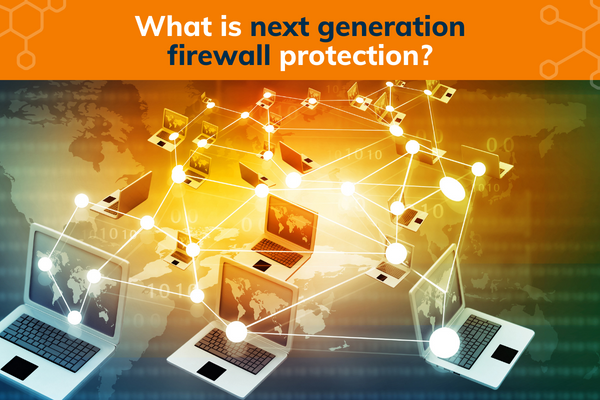
A next-generation firewall (NGFW) is a security device that monitors and processes network traffic and blocks potentially dangerous traffic based on administrator-defined rules. NGFWs evolve and expand upon the capabilities and features of traditional firewalls. They do all that a traditional firewall does, but in a more advanced manner, and with additional features.
What are the capabilities of an NGFW?
NGFWs can do everything that regular firewalls can do, which are:
- Packet filtering: Each packet of data is inspected and dangerous or unexpected packets are blocked
- Stateful inspection: Packets are read to make sure they are part of a legitimate network connection
- VPN awareness: Firewalls can identify encrypted VPN traffic and let it through
NGFWs also exhibit several other capabilities that older firewalls do not have, for example, NGFWs use deep packet inspection (DPI) in addition to packet filtering. According to Gartner, a global research and advisory firm, an NGFW must include:
- Standard firewall capabilities like Stateful Inspection
- Integrated intrusion prevention
- Application awareness and control to identify and block dangerous apps
- Threat intelligence
- Upgrade paths to include future information feeds
- Techniques to address evolving security threats
NGFW advantages
- Combines DPI with malware filtering and other controls to provide an optimal level of filtering
- Tracks all traffic from Layer 2 to the application layer for more accurate insights than other methods
- Can be automatically updated to provide current context
NGFW disadvantages
- To derive the biggest benefit, organisations need to integrate NGFWs with other security systems, which can be a complex process
- Costlier than other firewall types
What should a next-generation firewall contain?
A top-notch next-generation firewall must provide the following 5 benefits to organisations, from small and medium-sized businesses (SMBs) to enterprises.
1. Cybersecurity breach prevention and advanced security
The top priority of a firewall is to keep your organisation safe by preventing any infiltrations. Since the preventive measures are not 100% foolproof, your firewall should have an efficient second line of defence with advanced capabilities to detect complex malware if it creeps through your front-line defences. Your firewall must have the following capabilities:
- Ability to prevent any cyber-attacks before they get inside
- A cutting-edge, next-generation IPS (Intrusion Detection System) is built in to stop any intrusions fast
- URL filtering to restrict the websites and content that employees can access
- Built-in malware scanning called sandbox that continuously analyses file behaviour to detect and eliminate threats fast
- Empowering the firewall with a world-class threat intelligence organization to stop emerging threats
2. Broad network visibility
Constant monitoring of the network to be aware of what is happening in your network is vital. This will allow the firewall to stop any suspicious behaviour and curtail it instantly. Your firewall should be able to provide a comprehensive view of all the activities that are taking place in the network to see:
- Threat activity across users, hosts, networks, and devices
- The origin of a threat, where else it has spread, and what is the current status
- Active applications and websites
- Communications between virtual machines, file transfers, and more
3. Easy deployment and management options
Regardless of the size of your organisation — small to medium or a large enterprise — your firewall should meet your unique needs as follows:
- Management for every use case — choose from an on-box manager or centralised management across all appliances
- On-premises or in the cloud deployment via a virtual firewall
- Highly customisable to fit your needs — simply turn on subscriptions to get advanced capabilities
- Choose from a wide range of speeds
4. Fastest time to detection
The current industry standard time to detect a threat is between 100 to 200 days which is too late; A next-generation firewall should be able to:
- Detect threats in seconds
- Detect a successful breach within minutes or hours
- Prioritise alerts so you can be provocatively taking action against threats swiftly
- Deploy consistent policy that’s easy to maintain
- Allow policies with automatic enforcement across all the different areas of your organisation
5. Easy Automation and product integrations
Your next-generation firewall is of no use if it does not communicate with the rest of the security network. Choose a firewall that:
- Seamlessly integrates with other tools from the same vendor
- Is capable of integrating with other security solutions such as SIEM tools, reporting tools, two-factor authentication systems, etc. with little or no modifications
- Automatically provides threat information, event data, policy, and contextual information with email, web, endpoint, and network security tools
- Automates security tasks like impact assessment, policy management, and tuning, and user identification
- Enhances the overall capability of security systems of your organisation
Next-Generation Firewalls from Globalnet Solutions Australia
Globalnet Solutions Australia provides compact, high-performance, Next-Generation Firewalls with hardware-accelerated security services to protect mission-critical environments, data, and infrastructure. This is highly effective protection, with reliability and availability ideal for anyone — a small business, large enterprise, or public sector organisation.
We can also install virtual firewalls to Private / Hybrid / Public Cloud environments or implement policies to block threats flagged as malicious with Advanced Threat Prevention, operating via a Cloud service on the firewall.
For larger organisations we can offer comprehensive analytics available as add-ons.
